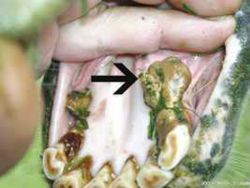Canine Teeth Disorders - Donkey
Calculus

The canine teeth (tushes) do not anatomically oppose each other, and this may be the reason why calculus (tartar), often extensive, can accumulate on them, especially the lower canines. Unlike with brachydont teeth, equine dental calculus is not a major predisposing factor to periodontal disease, although extensive calculus formation around the lower canine may cause ulcers of the adjacent lips. This calculus can be readily removed with strong forceps.
Displaced or Large Canine Teeth
Occasionally, displaced or grossly enlarged canine teeth will interfere with the bit, and such teeth should be extracted or ground down by a veterinary surgeon. Due to the great length (up to 7.5 cm long), and strong periodontal attachments of their reserve crown, general anaesthesia may be necessary for canine teeth extraction.
Some veterinarians advise that the sharp part of the clinical crown, or even the full clinical crown of the canine teeth, should be ground down, especially in donkeys that are having regular dental examinations. This is because these teeth can cause lacerations of the operator’s hands and arms during dental procedures, allegedly may interfere with the bit in some animals and can inflict severe damage to other donkeys during fighting. There is no agreement on this issue.
Wolf Teeth
Wolf teeth, with little justification, are blamed for many behavioural problems in donkeys and for interfering with the bit, and therefore, these teeth are frequently extracted. Some use the argument that because these teeth never do any good and may on occasions cause a problem, they always should be removed.
It is most likely that only displaced, enlarged or partially erupted wolf teeth, especially if present on the lower jaw, may cause oral pain or interfere with the bit. Wolf teeth are small structures (1 to 2 cm long) with no reserve crown. They can be readily extracted under local anaesthesia, with sedation if necessary, utilising a variety of specialised elevators or forceps.
Wolf tooth extraction is not necessarily an innocuous procedure. A major artery (the greater palatine artery) can be lacerated during wolf tooth extraction, and soft tissue infections or tetanus may also occur after extractions.
References
- Dacre, I., Dixon, P. and Gosden, L. (2008) Dental problems In Svendsen, E.D., Duncan, J. and Hadrill, D. (2008) The Professional Handbook of the Donkey, 4th edition, Whittet Books, Chapter 5
|
|
This section was sponsored and content provided by THE DONKEY SANCTUARY |
|---|